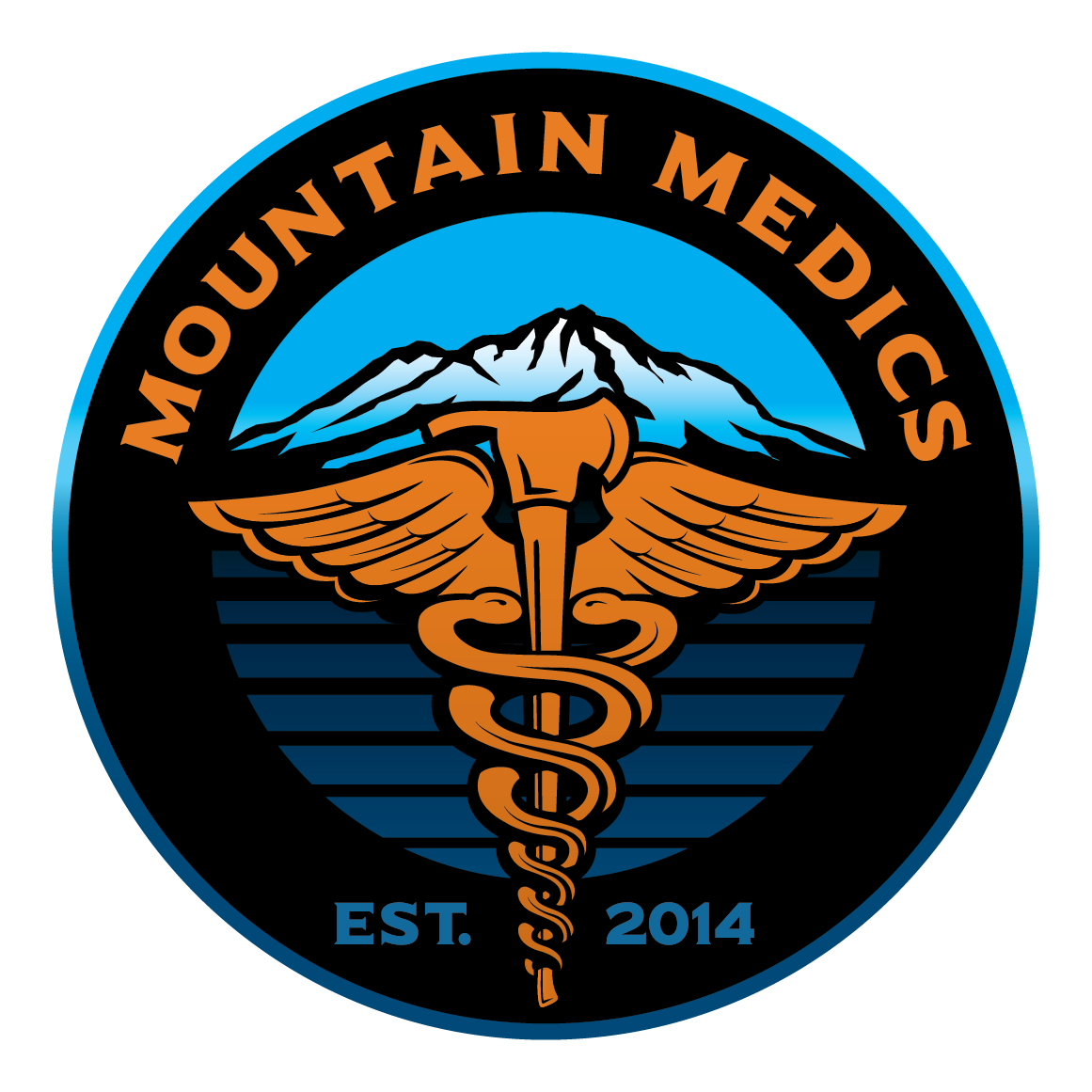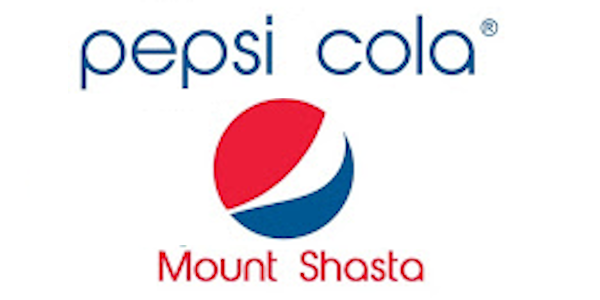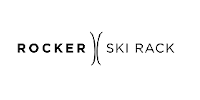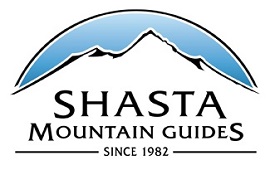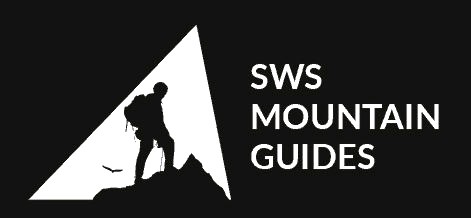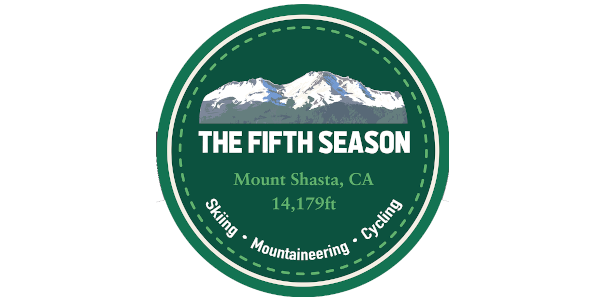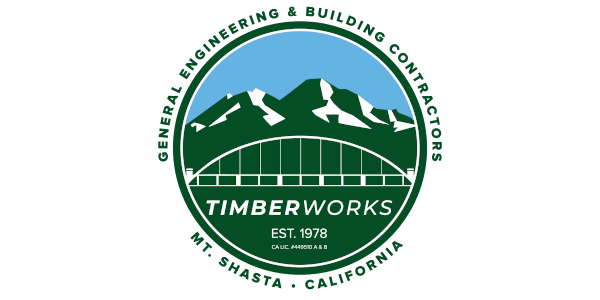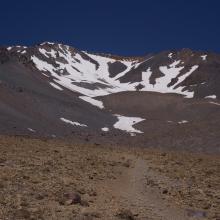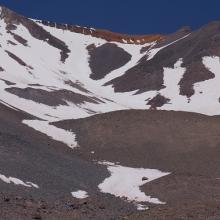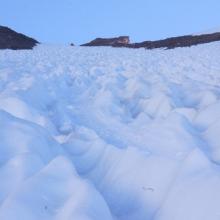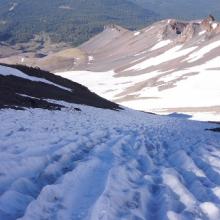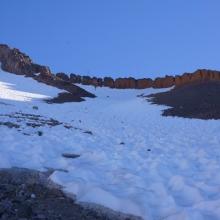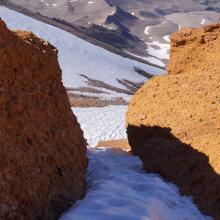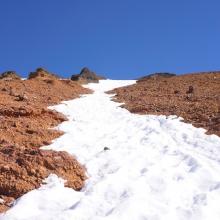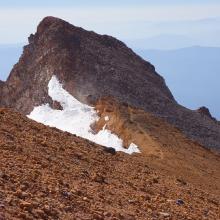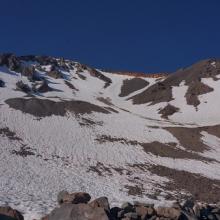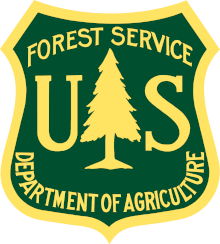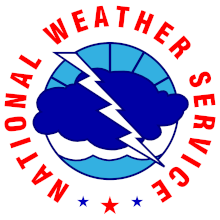You are here
08-20-2016-Avalanche Gulch
General Conditions
Avalanche Gulch is in POOR condition now. The two main hazards for this route currently are 1) rockfall and 2) a slip and fall INTO rocks. This is the time of year when rockfall is on the rise due to snow melting and exposing loose rock. Mt Shasta is one giant pile of rubble! As snow melts, rockfall increases. This is also the time of year when snow slopes begin to terminate into boulder strewn slopes. Snow slopes with rocks at the bottom drastically increases the consequences of a slip and fall. You MUST know how to self-arrest and you absolutely should wear a helmet, any time of year.
The sun cups on this route are now currently HUGE which makes for a very slow going climb. The better route to take for novices now is Clear Creek, a broadback ridge on the East side of the mountain. Or wait until next season to climb Avalanche Gulch.
The summer trail/route up to Lake Helen is completely melted out. (There is NOT a trail to the summit of Mt Shasta) From Lake Helen and up, snow will begin to be encountered. Snow shoes are not necessary, but climb and descend early to avoid post holing. Please stay on the trail! Do not attempt to take other routes.
Lake Helen still currently has some snow but plenty of dry camping is available on the south side of the moraine. No water is running at Lake Helen so plan on melting snow. You can fill up water at the Horse Camp spring also. The pee area is off to the east side of the moraine and down slope away from the camping area. Please use this area for all your bodily functions. It is REQUIRED to packout your human waste on Mt Shasta. Free human waste wag bags are available at all trailheads.
The Redbanks chutes are melting fast. The left chute or the notch are the best options through this section currently. You can descend the same way. The left chute is in the best condition now because it holds snow the longest and has continuous snow up through Redbanks and to Misery Hill. DO NOT glissade through the chutes. It's steep and easy to get out of control. The notch and thumb routes are options as well. Be careful of the Konwakiton Glacier bergschrund as it is beginning to melt out. While not a bottomless pit, one could certainly fall in at the right spot. Best to just stay off.
Misery Hill is melted out. Ascend Misery via the user trail. Cross the Summit Plateau and ascend the Summit Pinnacle. Be careful on top! You'll be out of breath, tired and may still have your crampons on. It is possible to fall off the top. It happened earlier this year to a climber. Be safe.
Summer is here, which means thunder cells can build up any day. Do not climb into white out conditions, or building thunder cells. It is quite common for climbers to become disoriented, and wander off of the wrong side of the mountain when above the Red Banks at 12,600 feet. Rock fall is another factor currently that should be watched for. The wind and daytime warming will encourage more rock fall. Rocks can break bones, knock you off of your feet, and send you tumbling down slope as well. The main area of rock fall happens above Lake Helen and below the Heart, but can happen anywhere, at any time day or night, up to the Red Banks.
For skiers you will have to carry gear to at least 9,500' and conditions above 10,000' are very poor, this includes sun cupping and debris on route. Warm temperatures will soften snow at the most elevations by about 11-11:30 providing for good glissading conditions, but not always. Elevation, aspect, and time of day will determine what kind of snow you find. Some days, wind and cooler temps may keep the snow firm, so don't count on glissading and/or soft corn snow up high on select days. While the avalanche danger is overall LOW, the avalanche danger will increase on S-SE-E aspects during the warmest parts of the day for loose wet point release slides. This type of snow instability may be triggered by skier/riders, climbers, or rock fall. While not particularly dangerous, enough snow may be entrained to knock one off of their feet and push them into undesirable terrain such as over a cliff, into rocks, or into a terrain trap where enough snow may collect to fully bury a person. An avalanche beacon, shovel, and probe are still currently advised. Just having the right gear doesn't make you safer on the mountain. The knowledge of how to use it properly, and knowing how to recognize avalanche terrain and associated avalanche problems is essential. Check the spring statement on our avalanche advisory page.
MANDATORY: Crampons, ice axe and a helmet and know how to use them!! You will also need stout winter worthy gear and equipment, and some experience with winter camping skill and survival. You will be on snow for about half of your climb. There is no running water at Lake Helen so bring extra fuel to melt snow. DO NOT glissade through Red Banks, and take off your crampons when you do decide to glissade. Control your speed!! PLEASE, wear a helmet and limit your exposure to rock and ice fall by moving laterally out of the fall line as you climb. Always keep an eye above for rock or ice fall, and yell "ROCK!" if you see one to warn other climbers below you.
CAMPING AT LAKE HELEN: PLEASE keep a clean camp...PACK OUT ALL micro trash, food scraps, coffee grounds, leftover pasta, you name it...please pack it out...Rangers take this VERY SERIOUSLY and so should you! Thousands of climbers camp here annually and it takes each of us to keep it clean. If you love what the mountains give you, then show them respect by packing out EVERYTHING and LEAVE NO TRACE. Keep it looking pristine for those that will visit after you, and for the preservation of WILDERNESS! Secure your tent and belongings well when you leave for the summit. Wind, ravens and the resident pine marten will spread your gear far and wide if it is left out. If your stuff is zipped up and stowed away well within your tent, you shouldn't have a problem. We have not had any issues with critters chewing through tents to get into stored food. SANITATION: Please urinate on the far EAST side of Lake Helen, AWAY from all camps. Use your pack-out bag over in this area as well. DO NOT urinate in the general camping area! Snow must be melted for water and we recommend treating it one of three ways: iodine, boil, or filter. Water is running at the spring at Horse Camp and the toilets are OPEN. Pack-out bags are mandatory for removing all solid human waste on the mountain. Pack-out bags are available at Bunny Flat.











